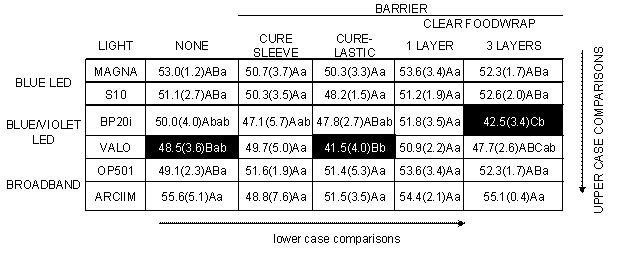Objectives: To determine the effect of curing tip barrier on conversion of a conventional light cured resin composite. Methods: Contemporary dental light curing units (Blue only LED [MAGNA, S10]; Blue/Violet (Bluephase 20i, VALO]; Broadband [Optilux 501, ARCIIM] were used to expose a 2-mm thick specimen of resin composite (C2 Body, Premise, Kerr) for 10s (except Optilux 501: 20s) through a variety of curing tip barriers: no barrier (control), two different type of commercial barriers (Curelastic; Cure Sleeve), or when covered by either 1 or 3 layers of a clear plastic food wrap. Composite was dispensed into a 2-mm high brass ring on a temperature controlled (30°C) attenuated total reflectance stage in the optical chamber of a Fourier transform infrared spectrometer. Lightguide ends were held 2 mm from the composite surface. A spectrum was obtained for the uncured composite, the light unit was activated, and additional spectra were obtained 10 minutes post-exposure (16 scans, 2 cm-1 resolution). Bottom surface monomer conversion was determined using standard methods of comparing changes in aliphatic-to-aromatic C=C peak ratios (1636 cm-1/1608 cm-1) in the cured and uncured states. N=5. Conversion values were compared among lights within each barrier material, and among barriers within a given light using ANOVA and the Tukey post-hoc test (pre-set alpha 0.05). Results: Table displays mean conversion values (sd) and statistical groupings within a given barrier (vertical, Upper Case letters) or within a curing light (horizontal, lower case letters).
Conversion decrease occurred using Cure-Lastic with the VALO light, or with 3 layers of food wrap on the BP20i. Conclusions: In general, use of curing barrier had no significant effect of the bottom composite conversion value 10 minutes following exposure. Barrier effects were not applied to any given light or barrier, but were found to be specific to unique combinations of the two.
Keywords: Curing-Light Barrier and Polymerization
See more of: Dental Materials 10: Instruments and Equipment
![[ Visit AADR's Website ]](images/banner.jpg)
